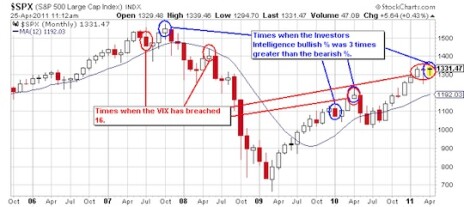It’s Different This Time
Two Sentiment Indicators
An ETF for Current Conditions
---
When you have been around investments and economics as long as I have, you hear certain phrases over and over again. These are a common few:
* Don’t put all your eggs in one basket.
* You can’t fight the Fed.
* A rising tide lifts all boats.
Most of these sayings have some merit. One that I’ve heard on several occasions that tends to worry me is, “it’s different this time.” I’ve heard it often enough and been around this industry long enough that I actually used that phrase as an article title ahead of the recession in 2007 and 2008.
This time I’m not talking about an inverted yield curve, but rather two sentiment indicators reaching bullish extremes. The Investors Intelligence Report (II) measures bullish and bearish percentages among investment publishers. When the bullish percentage has reached a level three times higher than the bearish percentage, corrections have occurred.
The other indicator is the CBOE Volatility Index (VIX), which recently breached the 16 level. The VIX is often referred to as the fear gauge of the market. When the VIX is high, fear is high. When the VIX is low, fear is low. As a contrarian, when fear is low, I get worried. Over the last five years, when the VIX has breached the 16 level, it has been a warning sign.
Take a look at the chart below. It shows the months when the II and the VIX breached their warning levels and how the S&P reacted in the ensuing months.
What this chart suggests to me is that we are playing with fire in the market right now. Sure there have been a few times when the market moved higher for a short period following these signals, but the moves higher were short lived and they were not big moves. It seems there is more risk than reward right now. I’m not suggesting that we are in for another bear market like 2007-2009, but rather a correction. I foresee two or three months of selling that causes the indexes to dip approximately 10%-15%.
The overbought/oversold indicators on the monthly charts are the highest they have been since 2007 as well, and a pullback would go a long way toward getting the indexes out of overbought territory.
--- Advertisement ---
The Top 15 Dividend Aristocrats of 2011
Discover the “gold standard” in dividend-generating investments with our latest special report. In it, we highlight the creme de la creme of dividend players.
Our top 15 Dividend Aristocrat picks for 2011 are culled straight from the 200-plus investment advisories we follow here at Dick Davis Dividend Digest. These are must-own income investments for anyone serious about dividends.
Get your copy of the report today!
---
Now, I’m not suggesting that you rush out and sell all of your stock holdings, nor am I suggesting that you load up on nothing but puts at this point in time. It would be prudent to take some gains off the table on any long positions you may have. It’s also not a bad idea to add some insurance in the way of puts on the main exchange-traded funds (ETF) like the S&P 500 SPDR (SPY). This would allow you to hang on to your stock holdings but have a hedge against a decline. Just like insurance on our car, we hate paying the premiums, but we sure are glad we have it when we need it.
If you’re not a fan of options, but would like to add some protection against a possible correction, you could add an inverse ETF to your portfolio. If your portfolio is made up of mostly blue chip stocks, an inverse ETF on the S&P 500 would be your best protection:
* ProShares UltraShort S&P 500 Fund (SDS)--This is a leveraged ETF that goes up 2% when the S&P declines 1%.
* ProShares Short S&P 500 (SH)--This is a regular inverse ETF that is designed to go up 1% when the S&P declines 1%.
If your portfolio has a lot of tech stocks in it, you might want to consider an ETF that is based on the movements of the QQQ.
* ProShares UltraShort QQQ (QID)--A leveraged inverse ETF designed to increase by 2% for every 1% decline in the Nasdaq 100 Trust (QQQ).
* ProShares Short QQQ (PSQ)--This is a regular inverse ETF that is designed to go up 1% when the QQQ declines 1%.
There are inverse ETFs for individual sectors and many other indexes. You will want to pick one that gives you the best protection based on the holdings in your portfolio. Again, I’m not saying that another bear market is on the horizon, but a correction looks like a very high probability scenario.
It could end up being different this time, but history suggests otherwise and taking out a little insurance to protect your assets isn’t a bad idea.
Sincerely,
Rick Pendergraft
For Cabot Wealth Advisory
P.S. Leverage your investments to make money in all markets! Cabot Options Trader Editor Rick Pendergraft uses the market’s volatility to bring his subscribers huge profit-making opportunities. Just check out these gains from the last three months: a 128% gain on Maxim Integrated Products Call in 15 days … a 70% gain on a Linear Technology Call in only 11 days … and a 164% gain on a Cisco Put in ONE day! Join today!
